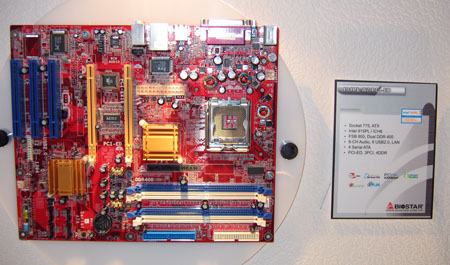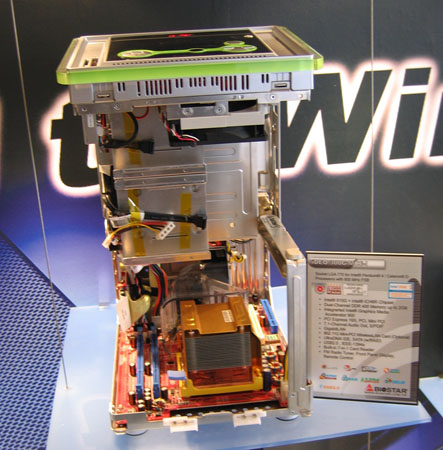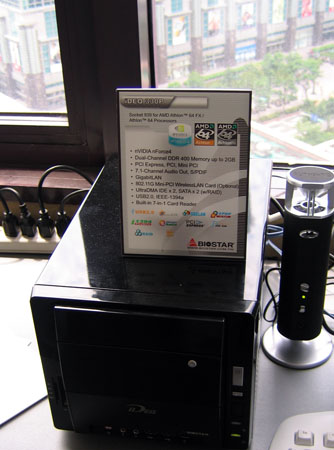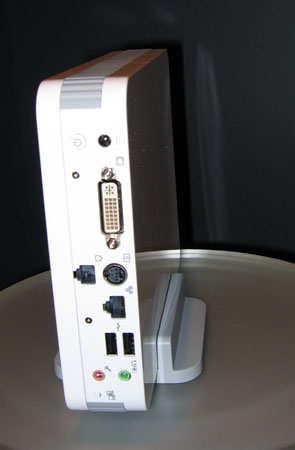Computex 2005 - Day 3 Tidbits
by Kristopher Kubicki on June 1, 2005 11:06 PM EST- Posted in
- Trade Shows
Biostar
Everyone and their brother had 945P motherboards on display this week, and some had dual 16 lane PCI-E interfaces on their motherboards. The dual x16 is actually slightly misleading, since the second adaptor is really just an x4 in an x16 slot. Since saturation of the PCI-E bus is something that graphic manufacturers still dream about, we aren't giving anyone a hard time about only putting 4 or 8 lanes on an x16 interface (yet).But Biostar didn't just have a 945P motherboard with two graphics adaptors. They also had a 915P board with two as well! Practical? Perhaps not - but unique? Absolutely. As cheap as other 915P motherboard prices have fallen in the last few months, a new, inexpensive 915P motherboard with extra room for graphics might find some niche somewhere. In the remote opportunity that NVIDIA opens its SLI driver to steal ATI's Crossfire thunder, some of these 915P and 945P dual graphics motherboards are actually capable of rudimentary "SLI" performance.
Biostar's real focus this year was on the small form factor (SFF). An entire room in the Biostar suite was dedicated to SFFs, with plenty of 945G and nForce4 designs. However, we didn't see an nForce4 SLI setup like we did at Shuttle's suite yesterday.
Biostar did have an SFF based on C51G - a.k.a. nForce4 IGP. Some of the finer points about the chipset are revealed in the note card next to the system, including integrated 6200TC graphics and 7.1 channel audio (not SoundStorm 2).
Intel
Speaking of SFF, Intel partnered up with FIC to produce one of the most unoriginal, but still interesting, looking products to enter the small form factor world. The Mac-Mini knockoffs are based on Pentium M processors and only require a single internal fan.The DC inverter is not housed inside the system, but all other components are. The SFF units are primarily legacy free, but have a traditional RJ-11 input for what we can only guess is caller ID. The booth claims that the Mini-knockoffs are for the digital home, but the lack of HDMI indicates otherwise for us. Since these are proof-of-concept machines, we can't criticize them too much - but don't expect to see something like this anytime soon at Fry's.
















35 Comments
View All Comments
KristopherKubicki - Friday, June 3, 2005 - link
Thanks for the update DoctorBooze. The details I got were just from a quick conversation with a VP at NetCell. It sounds like their tech is going to be on some motherboards in the near future, so hopefully by then I'll have more details.Kristopher
DoctorBooze - Friday, June 3, 2005 - link
Couple of points about all this RAID stuff. The RAID level described in the article is RAID 4, not RAID 3; RAID 3 uses byte-level striping, not block-level. RAID 3 needs synchronised spindles for adequate performance because, to read a whole block back, you have to read off all the discs except the parity disc. Most implementations will also read back the parity and make sure the data is valid; there's no performance hit for this. Overall, RAID 3 reads and writes about as fast as a single drive (whether you have validation enabled or not). It's a very safe way to store your data, as it'll pick up single-sector faults and correct for them (and the controller or OS can subsequently mark the block as bad with no harm done).RAID 4 and RAID 5 do not require synchronised spindles because they operate at a block level, so for any block of data you only have to read one disc, and if they validated the data, they'd be as slow as RAID 3 (because they'd have to read the contents of all the discs to retrieve and validate one block, which would mean you got none of the benefits of parallelism). RAID 4 and 5 only protect against faulty sectors if the drives report them as faulty rather than just returning duff data.
KristopherKubicki - Friday, June 3, 2005 - link
Re: All the comments about RAID5 - I may be a little biased, but the cannotation was *good* RAID5 support in kernel!Kristopher
KristopherKubicki - Friday, June 3, 2005 - link
JHutch: RAID3 is pretty much identical to RAID5 except that RAID3 dedicates a whole disk to parity.RyanVM: I might have phrased it incorrectly - but we meant to say don't expect to see a new card between X550 and R520.
Kristopher
fsardis - Friday, June 3, 2005 - link
is it just me or the new stacker 830 has 9 bays instead of 12? how can it be bigger than the original stacker then as mentioned in the article?LidlessEye - Friday, June 3, 2005 - link
Rebuild time shouldn't be quite that long... depending on other I/O and the RAID controller, I'm sure. But if there's a lot of I/O, you shouldn't be using ATA anyway... the probability of a failure even if it takes a day is miniscule. Also, since it wasn't pointed out in the article, RAID 10 or 0+1 offers much greater I/O and nearly the same fault tolerance for four disks, I would use 0+1 at 6 disks (instead of five in RAID 6). So that leaves RAID 6 for 7 or more drives... 14 is often cited as a "common" configuration. FWIW, EMC and IBM recommend RAID 10 and 5 in most of their SAN gear.USAF1 - Thursday, June 2, 2005 - link
@#25The other issue with RAID-3 is that all disks in the array are spindle synchronized. So, your I/O's per second are also limited to that of a single drive. By contrast, RAID-5 allows for independent control of all hard drives in the array. RAID-3 is great for streaming large, contiguous files but not much else. I have 18TB of CIPRICO RAID-3 devices where I work and I wish I didn't...
Doormat - Thursday, June 2, 2005 - link
Its coz rebuild time on a 10k or 15k 73GB SCSI HD is not that long. On an 8 drive 7200RPM 400GB(per drive) array, rebuild times are on the order of days.LidlessEye - Thursday, June 2, 2005 - link
oh... also, very few people use it in the server world since it so slow, and array failure due to two drive failures is generally caused by negligence, not rebuild time. I would never want to use it for a small array (<7 disks).LidlessEye - Thursday, June 2, 2005 - link
Windows has offered software RAID 5 since at least NT4. So it’s been available for about a decade…RAID 6 is worthless except in very large array sets (like 14 drives) for data archival mainly. Compaq (now HP) has offered this (Called RAID ADG) for about 5 years on their SCSI RAID controllers, and of course that’s in hardware. I believe IBM has offered it for a few years as well.